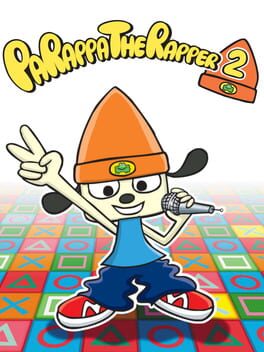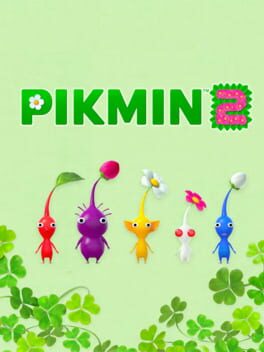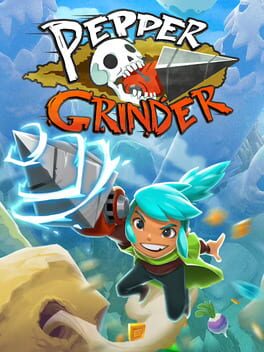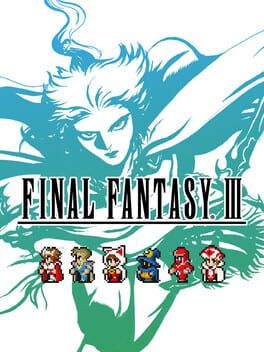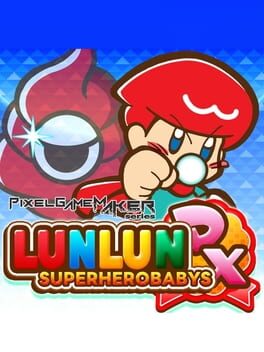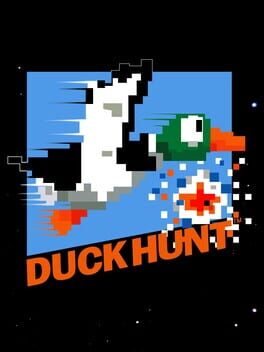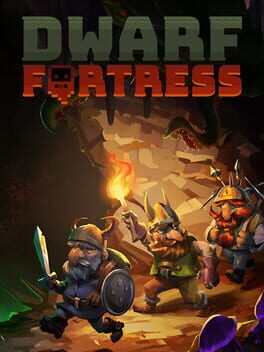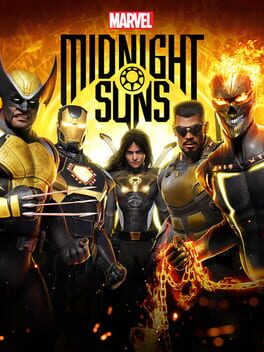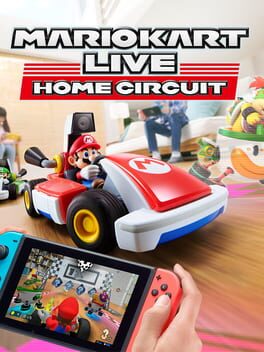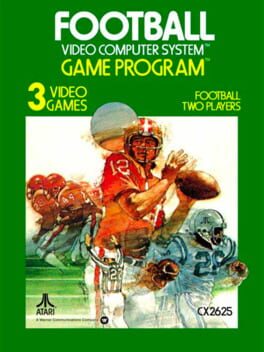CherryLambrini
159 Reviews liked by CherryLambrini
PaRappa the Rapper 2
2001
Needed a palate cleanser game, and played this because it's something that I had on PS Plus and could be finished in less time than it takes to watch a film. Sort of lacks some charm compared to the original or Um Jammer Lammy, and there seems to be a bit of an input delay so you basically have to learn to press everything slightly ahead of time. Still a decent time though.
Pikmin 2
2023
I believe in Pikmin. I am certain that human life will end through nuclear war or ecological negligence, and someday a funny little man will land here on a spaceship and pluck doting vegetable guys out the ground to fight mutant spiders and frogs. I think the setting raises interesting and prescient ideas about the nature of survival and social hierarchies. It's the central reason I have such a problem with Pikmin 1 receiving a staight-to-VHS comedy sequel.
Having survived the first game by the skin of his teeth, Olimar arrives home and is immediately sent back to Pikminland because his boss is skint. I hate this miserable coda. I hate that his longing to see his family again is put on hold to chase money. I hate that earth is immediately seen as a place to mine for resources. I think there's a kind of dark satire about capitalistic greed in it, but I do not enjoy this part of the fantasy. I feel sick.
Pikmin 2 isn't a game about survival anymore. There's no time limit, except the daily clock, which seems more of an irritation here than the structural grounding it served as in the original game. The game's more willing to kill off your Pikmin now, because you can just go farm more. Olimar and Louie can stay here as long as they want, and seemingly, the only reason to rush is to complete the game with a score you can boast about. There's still the familiar Pikmin gameplay, but that's largely relegated to the overworld sections. The bulk of Pikmin 2's content is found in the caves; RANDOMLY GENERATED dungeons with a series of floors to excavate treasures from. Pikmin 2's quite antithetical to 1's carefulness. The Pikmin are fodder now. If they die, tough luck. Fuck your wasted time. Go find some more and try again. They probably don't have souls, right?
I've got as much distaste for randomly generated content and roguelikes as anyone, and it's a big sticking point with the game for me. It's tempting to lay it on too thick. In reality, Pikmin 2 is generating content from a fairly well-crafted library of pieces. There's still humanity in the product. Some cave floors are clever and creative. One uses a toy train track to create a central barrier that Pikmin can walk on top of without falling off, but they can walk under the drawbridge. It's cute and smart, even if it does undercut the game's setting pretty dramatically. Random elements generally come in the form of enemy and item placement, and it never creates anything unplayable, even if there are a few too many dead ends and groups of explosive nightmares.
This review follows the new Switch release of the game. It's an awkward thing. I became a Pikmin fan through the original Wii U release of 3, and the New Play Control versions of 1 and (to a lesser extent) 2. To me, pointer controls are just how Pikmin is supposed to play. I'm aware there's GameCube folk who think being able to aim all over the screen messes with the intended balance, but it's just a much more deliberate aiming system than wobbling a cursor based on where your character's facing. I think 4's implementation of a lock-on system was a decent compromise, but Nintendo's already come up with the solution to this problem. Going back to the classic controls feels like playing an FPS on the Dreamcast. There is motion control support in here, but it's the airyfairy implementation from 4, where you can manipulate your cursor within the character's throwing range, and it doesn't feel any easier or more intuitive than just accepting the rudimentary 2001 standard.
In an act of curious apathy, Nintendo have chosen to base the widescreen implementation on the Wii version's clumsy presentation. While gameplay and cutscenes are presented in a native 16:9 aspect ratio, menus and text are consistently stretched to fit the dimensions of modern TVs. As the traumatised Captain Olimar is sent back to PNF-404, I'm being dragged back into the horror of friends' 2004 living rooms to suffer wrong-looking Simpsons.
I'll admit I've had a better time with Pikmin 2 on Switch than I did on my initial Wii playthrough. Knowing this is the one I didn't have much emotional attachment to helped warm me to the idea of the Pikmin gameplay grab-bag. It's a shallow pleasure, and I'd be callous enough to suggest its biggest fans have shallow appreciation for the games' setting. That said, previous releases of the game featured licensed products as its "treasures", and I've always felt a bit of a thrill from their subversive implication. The human race is dead, and the only remaining evidence of their civilisation is capitalistic waste. The Duracell batteries and Haribo bags are, understandably, not in this new version, I'll always have a bit of respect for Pikmin 2 for how it egged corporations into painting themselves as the problem.
Some people think Pikmin 2 is the best in the series. Who am I to say otherwise? Maybe you'll love it. I just hope I helped you understand why I really don't.
Having survived the first game by the skin of his teeth, Olimar arrives home and is immediately sent back to Pikminland because his boss is skint. I hate this miserable coda. I hate that his longing to see his family again is put on hold to chase money. I hate that earth is immediately seen as a place to mine for resources. I think there's a kind of dark satire about capitalistic greed in it, but I do not enjoy this part of the fantasy. I feel sick.
Pikmin 2 isn't a game about survival anymore. There's no time limit, except the daily clock, which seems more of an irritation here than the structural grounding it served as in the original game. The game's more willing to kill off your Pikmin now, because you can just go farm more. Olimar and Louie can stay here as long as they want, and seemingly, the only reason to rush is to complete the game with a score you can boast about. There's still the familiar Pikmin gameplay, but that's largely relegated to the overworld sections. The bulk of Pikmin 2's content is found in the caves; RANDOMLY GENERATED dungeons with a series of floors to excavate treasures from. Pikmin 2's quite antithetical to 1's carefulness. The Pikmin are fodder now. If they die, tough luck. Fuck your wasted time. Go find some more and try again. They probably don't have souls, right?
I've got as much distaste for randomly generated content and roguelikes as anyone, and it's a big sticking point with the game for me. It's tempting to lay it on too thick. In reality, Pikmin 2 is generating content from a fairly well-crafted library of pieces. There's still humanity in the product. Some cave floors are clever and creative. One uses a toy train track to create a central barrier that Pikmin can walk on top of without falling off, but they can walk under the drawbridge. It's cute and smart, even if it does undercut the game's setting pretty dramatically. Random elements generally come in the form of enemy and item placement, and it never creates anything unplayable, even if there are a few too many dead ends and groups of explosive nightmares.
This review follows the new Switch release of the game. It's an awkward thing. I became a Pikmin fan through the original Wii U release of 3, and the New Play Control versions of 1 and (to a lesser extent) 2. To me, pointer controls are just how Pikmin is supposed to play. I'm aware there's GameCube folk who think being able to aim all over the screen messes with the intended balance, but it's just a much more deliberate aiming system than wobbling a cursor based on where your character's facing. I think 4's implementation of a lock-on system was a decent compromise, but Nintendo's already come up with the solution to this problem. Going back to the classic controls feels like playing an FPS on the Dreamcast. There is motion control support in here, but it's the airyfairy implementation from 4, where you can manipulate your cursor within the character's throwing range, and it doesn't feel any easier or more intuitive than just accepting the rudimentary 2001 standard.
In an act of curious apathy, Nintendo have chosen to base the widescreen implementation on the Wii version's clumsy presentation. While gameplay and cutscenes are presented in a native 16:9 aspect ratio, menus and text are consistently stretched to fit the dimensions of modern TVs. As the traumatised Captain Olimar is sent back to PNF-404, I'm being dragged back into the horror of friends' 2004 living rooms to suffer wrong-looking Simpsons.
I'll admit I've had a better time with Pikmin 2 on Switch than I did on my initial Wii playthrough. Knowing this is the one I didn't have much emotional attachment to helped warm me to the idea of the Pikmin gameplay grab-bag. It's a shallow pleasure, and I'd be callous enough to suggest its biggest fans have shallow appreciation for the games' setting. That said, previous releases of the game featured licensed products as its "treasures", and I've always felt a bit of a thrill from their subversive implication. The human race is dead, and the only remaining evidence of their civilisation is capitalistic waste. The Duracell batteries and Haribo bags are, understandably, not in this new version, I'll always have a bit of respect for Pikmin 2 for how it egged corporations into painting themselves as the problem.
Some people think Pikmin 2 is the best in the series. Who am I to say otherwise? Maybe you'll love it. I just hope I helped you understand why I really don't.
Pepper Grinder
2024
RoboCop: Rogue City
2023
Final Fantasy III
2021
Now, you'll observe that the curve goes up for what makes a Final Fantasy game good almost in direct proportion to being able to turn off random encounters. Autosaving presents its own variable in--
Drops pointer. Bends over and splits pants open. Farts loudly. Falls over and knocks down the dry erase board and farts again. Gains 1,000 followers.
Drops pointer. Bends over and splits pants open. Farts loudly. Falls over and knocks down the dry erase board and farts again. Gains 1,000 followers.
Super Mario Bros. is part of my DNA. It's a Backloggd cliche to begin a review with an assertion that a multimedia franchise is a fundamental component of your soul, but I think it's worth prefacing this review with the knowledge that my first introduction to the concept of "video games" was playing Super Mario Bros. 2 on a black-and-white TV barely connected by exposed tin wire to a NES that had been confiscated from my dad's friend's deadbeat stoner son; I was electrified (both literally and figuratively) from the moment I first entered Subspace, and Mario and his posse have been a regular feature in my life ever since. Just recently my brother and I went to see The Super Mario Bros. Movie, and the first thing we talked about afterward was that it was cool that they kept the biddybuds walk cycle true to the games. That doesn't happen unless a Super Mario has fundamentally rearranged the genetic code you share.
Wonder’s greatest delight is its history, and in many ways, it’s the Ultimate entry in the 2D Mario series. Nothing is overtly categorised or labeled as it is in Smash Bros., but it’s all there for us, the fans, to see; at least a half-dozen character/istics from each prior entry make an appearance, and they often elicit the same brain tingles as my precious biddybud-based ASMR at the cinema last year. That’s a special sort of feeling that you can’t wrap in a Backloggd cliche, but basically what I’m trying to say here is that I pogged the fuck out when I got the Wonder Seed in High-Voltage Gauntlet.
The subtle art of referencing is not lost here, despite the relegation of Mario’s makers to “supervising director” roles in the credits (this children’s toy is an incredibly classy affair!). Like Ultimate, though, I think Wonder’s biggest strength is also the cause of an identity crisis - this is a buffet of all the other Mario games (and Rayman Legends) with no distinct flavour beyond talking to tiny caterpillars at great length about statecraft. Despite the intentionality of the hijinks, game mechanics, visuals and music are majority non-distinct, and the aforementioned Metal Mario sample only serves to highlight how little else the game has to offer of its own self beyond genteel appeals to the part of my hippocampus that remembers one particular kind of jump from Super Mario Bros. 2.
In Francis Fukuyama's The End of History and the Last Man, Fukuyama argues that with the end of the Cold War and the collapse of communism, humanity has reached the end point of ideological evolution. He suggests that liberal democracy, emphasizing individual rights, political pluralism, and free-market capitalism, represents the ultimate form of government and is the culmination of the ideological struggles that have characterised history.¹
The key message of the book² is that liberal democracy, as exemplified by Western societies, represents the endpoint of humanity's sociocultural evolution and that further developments in the political and economic realms are unlikely to result in a fundamentally different or superior system. Fukuyama contends that liberal democracy has triumphed over other ideologies, such as fascism and communism, and has become the universally accepted political and economic organisation model.
In 2024, Nintendo Co., Ltd.’s resounding triumph over its former rivals potentially represents the endpoint of Super Mario’s sociocultural evolution. What Super Mario Bros. Wonder proves to us is that developments in the realm of Super Mario Bros.-based gameplay are unlikely to result in a fundamentally different or superior video game. I contend that Super Mario has triumphed over his former foes, such as Sonic and Zool, and has become the universally accepted model for jumping on turtles.
Fuck it, at least they added a grappling hook.
-----
¹ Don’t worry. I haven’t read this book or even checked its Wikipedia synopsis. I was too busy collecting all the bonus Wonder Seeds in Super Mario Bros. Wonder.
² A book is a physical publication that consists of pages containing written or printed material, usually bound together along one edge. Books can cover a wide range of topics and genres, including fiction, non-fiction, poetry, reference, and more. They serve as a medium for conveying information, storytelling, and expressing ideas. Traditional books are typically made of paper, with ink or other printing methods used to display text and images.
-----
(Also the co-op mode is one hundred times more oppressive than New Super Mario Bros. and almost lead to my wedding getting cancelled, thanks Nintendo)
Wonder’s greatest delight is its history, and in many ways, it’s the Ultimate entry in the 2D Mario series. Nothing is overtly categorised or labeled as it is in Smash Bros., but it’s all there for us, the fans, to see; at least a half-dozen character/istics from each prior entry make an appearance, and they often elicit the same brain tingles as my precious biddybud-based ASMR at the cinema last year. That’s a special sort of feeling that you can’t wrap in a Backloggd cliche, but basically what I’m trying to say here is that I pogged the fuck out when I got the Wonder Seed in High-Voltage Gauntlet.
The subtle art of referencing is not lost here, despite the relegation of Mario’s makers to “supervising director” roles in the credits (this children’s toy is an incredibly classy affair!). Like Ultimate, though, I think Wonder’s biggest strength is also the cause of an identity crisis - this is a buffet of all the other Mario games (and Rayman Legends) with no distinct flavour beyond talking to tiny caterpillars at great length about statecraft. Despite the intentionality of the hijinks, game mechanics, visuals and music are majority non-distinct, and the aforementioned Metal Mario sample only serves to highlight how little else the game has to offer of its own self beyond genteel appeals to the part of my hippocampus that remembers one particular kind of jump from Super Mario Bros. 2.
In Francis Fukuyama's The End of History and the Last Man, Fukuyama argues that with the end of the Cold War and the collapse of communism, humanity has reached the end point of ideological evolution. He suggests that liberal democracy, emphasizing individual rights, political pluralism, and free-market capitalism, represents the ultimate form of government and is the culmination of the ideological struggles that have characterised history.¹
The key message of the book² is that liberal democracy, as exemplified by Western societies, represents the endpoint of humanity's sociocultural evolution and that further developments in the political and economic realms are unlikely to result in a fundamentally different or superior system. Fukuyama contends that liberal democracy has triumphed over other ideologies, such as fascism and communism, and has become the universally accepted political and economic organisation model.
In 2024, Nintendo Co., Ltd.’s resounding triumph over its former rivals potentially represents the endpoint of Super Mario’s sociocultural evolution. What Super Mario Bros. Wonder proves to us is that developments in the realm of Super Mario Bros.-based gameplay are unlikely to result in a fundamentally different or superior video game. I contend that Super Mario has triumphed over his former foes, such as Sonic and Zool, and has become the universally accepted model for jumping on turtles.
Fuck it, at least they added a grappling hook.
-----
¹ Don’t worry. I haven’t read this book or even checked its Wikipedia synopsis. I was too busy collecting all the bonus Wonder Seeds in Super Mario Bros. Wonder.
² A book is a physical publication that consists of pages containing written or printed material, usually bound together along one edge. Books can cover a wide range of topics and genres, including fiction, non-fiction, poetry, reference, and more. They serve as a medium for conveying information, storytelling, and expressing ideas. Traditional books are typically made of paper, with ink or other printing methods used to display text and images.
-----
(Also the co-op mode is one hundred times more oppressive than New Super Mario Bros. and almost lead to my wedding getting cancelled, thanks Nintendo)
Here's your hook - LUNLUN SUPERHEROBABYS DX was developed by a mother for her six children. What's the development story behind your last videogame purchase? You feeling good about yourself now, huh?
LUNLUN SUPERHEROBABYS DX is a very unusual game, and there's not a lot of documentation on it online (particularly not in English), but when I mentioned I was playing the game on Twitter, I was retweeted by the legend, LunLun Games herself, giving me a little more insight into this curious home project.
£4-ish on the eShop, the description tells us that Baby Lunlun has "been eaten by the giant & evil Boss Poo!", and we have to help him escape, platforming, boosting and hammering his away through the poo's innards. You start in a sort of Kirby's Adventure-style hub world, flooded with coins, enemies (more poos), and several doorways. Behind each door is a miniboss (mostly poos). In a move perhaps inspired by Breath of the Wild, you can head straight to the finish at any point, but the more minibosses you defeat, the easier the final battle with Boss Poo will be.
At the top-left corner of the screen is a number. This acts as a time counter, health bar and power meter. The more coins you collect and enemies you attack, the higher it rises. Get over a 100 and you'll be able to launch a special attack that can defeat any enemy in an instant. It's actually quite an elegant system.
The central gimmick of LUNLUN SUPERHEROBABYS DX is "Anyone can play!", which the ESRB might have something to say about, as they determine the extensive display of feces makes the game unsuitable for children under the age of 10.
There isn't a lot to rave about in LUNLUN SUPERHEROBABYS DX. While there's an undeniable scruffiness to it, the art and music are surprisingly competent, and the core gameplay is fun enough. The tone is amusingly odd, and that carries through to the writing. Unlike a lot of very cheap, weird eShop games, there's a good degree of game design literacy at display here, with ideas seemingly rooted in Zelda, Gradius, Sonic and Kirby. It's game snob friendly, which is admirable for a game that's only really intended to be an amusing diversion for young children. The game's description suggests that "while the game was made with care for players of all ages, there might be some areas still challenging for some children. Please be a dear and help them out!"
I can't say this is a strong recommendation, but I admire LUNLUN SUPERHEROBABYS DX. Its intentions are very modest, and I appreciate that. I don't expect a mother of six to be able to create a top-tier videogame on her own, but this is a charming little release. I just hope I'm not the only baby amused by it.
LUNLUN SUPERHEROBABYS DX is a very unusual game, and there's not a lot of documentation on it online (particularly not in English), but when I mentioned I was playing the game on Twitter, I was retweeted by the legend, LunLun Games herself, giving me a little more insight into this curious home project.
£4-ish on the eShop, the description tells us that Baby Lunlun has "been eaten by the giant & evil Boss Poo!", and we have to help him escape, platforming, boosting and hammering his away through the poo's innards. You start in a sort of Kirby's Adventure-style hub world, flooded with coins, enemies (more poos), and several doorways. Behind each door is a miniboss (mostly poos). In a move perhaps inspired by Breath of the Wild, you can head straight to the finish at any point, but the more minibosses you defeat, the easier the final battle with Boss Poo will be.
At the top-left corner of the screen is a number. This acts as a time counter, health bar and power meter. The more coins you collect and enemies you attack, the higher it rises. Get over a 100 and you'll be able to launch a special attack that can defeat any enemy in an instant. It's actually quite an elegant system.
The central gimmick of LUNLUN SUPERHEROBABYS DX is "Anyone can play!", which the ESRB might have something to say about, as they determine the extensive display of feces makes the game unsuitable for children under the age of 10.
There isn't a lot to rave about in LUNLUN SUPERHEROBABYS DX. While there's an undeniable scruffiness to it, the art and music are surprisingly competent, and the core gameplay is fun enough. The tone is amusingly odd, and that carries through to the writing. Unlike a lot of very cheap, weird eShop games, there's a good degree of game design literacy at display here, with ideas seemingly rooted in Zelda, Gradius, Sonic and Kirby. It's game snob friendly, which is admirable for a game that's only really intended to be an amusing diversion for young children. The game's description suggests that "while the game was made with care for players of all ages, there might be some areas still challenging for some children. Please be a dear and help them out!"
I can't say this is a strong recommendation, but I admire LUNLUN SUPERHEROBABYS DX. Its intentions are very modest, and I appreciate that. I don't expect a mother of six to be able to create a top-tier videogame on her own, but this is a charming little release. I just hope I'm not the only baby amused by it.
Super Mario RPG
2023
There's definitely a vibe to Super Mario RPG. This isn't nostalgia talking. I didn't play the game until 2017, on the SNES Mini. But the music, the writing, the sequence of tasks you have to perform... this is the game Squaresoft made when they thought Final Fantasy VII was going to be an N64 project. It's a silly, kid-friendly fairytale RPG, but there's a real through line from this to both Final Fantasy VII and Ocarina of Time. It's not that games don't make us feel like they used to when we kids. They just stopped making them like this.
So much of what I love about Mario RPG is in its presentation. It was a real technical achievement on the SNES, but that meant it was pushing against boundaries in every direction. I mean, really, this was an isometric RPG with pre-rendered graphics and a very prominent jump button, and that was about as 3D as you were getting in an adventure game back then. Characters had very limited poses to communicate with, and they opted to keep Mario mute as he gave direct responses to NPCs, expressing himself through pantomime and, again, his trademark jumping. It's a bit of a puppet show, and it's deeply endearing.
Removing the limitations of an old game is always hazardous, and particularly when that carries so much of its appeal. New developers, ArtePiazza, have earned Square Enix's trust from decades of ports and remakes, spanning all the way back to the Super Famicom version of Dragon Quest III, and they've taken great pains to stay faithful to the original game's charm, though you can feel the stress they were under, taking Zoom meetings with Shigeru Miyamoto and Tetsuya Nomura. Playing this game is accepting that it's going to look like a Fancy Modern version, discarding the funny old sprites, and past that, there's very little for the old guard to grumble about. Hell, the bulk of the characters still look like beautifully crude old CGI.
There's a suite of quality of life tweaks that take much of the old SNES RPG pain out of the experience. Downed characters can be swapped mid-battle, timing-based attacks now give a little heads up to help you figure out when you're supposed to press A, and the game's constantly auto-saving. It's less of a commitment. Yes, I like the tension that comes from not knowing when you'll be allowed to turn a game off, but I was still using save states when I played on the SNES Mini. I'm not kidding on that we had it better off in the nineties.
I really don't know what younger audiences will make of this, though. Seeing copies sitting on the shelves of Smyths Toys, with the no-nonsense "MARIO RPG" title and stark box art, it doesn't come with a disclaimer that says "THIS CONTROLS A BIT LIKE LANDSTALKER". If you're not already well versed in 16-Bit games, the game could feel really stiff and awkward. This is a game before there was a consensus on what Mario sounded like. Are kids going to understand why he's not whooping and exclaiming with every jump? Let's face facts. People who have first-hand experience of the 1996 release line-up are fucking old now. Most people buying Mario games aren't us. Are they going to understand? And if not, why doesn't Princess Peach look like the crude assembly of geometric shapes that she did on the SNES? There's concessions made for the modern perception of the Mario brand here, and they really clash against the eight-way movement system and silent text boxes. I think it's a real downer that they couldn't fully commit to the bit.
There's new FMV cutscenes that mimic the movement and animation of the original. I'm sure there's a certain kind of player who will see these and gasp in awe. They're not me, though. I don't think they're anywhere near as charming when freed of the static perspective. Again, this isn't a game that I've had a long relationship with. If I'd played the game at a more impressionable age, and fantasised about a more tangible version of its world, maybe it would have done something for me. I just like the old approach more.
So, it's bittersweet in all. A compromise. A better-playing version of a game I really like, but a version I like less overall. When I next want to play Mario RPG, I honestly don't know whether I'll play this or the SNES version. In all likelihood, I'll grumble about the indecision and play something else altogether. That's a shame. The game's really good, I like it a lot, and I respect the people who worked on this new version. If you want to play Mario RPG, I think the Switch release is the much more reasonable recommendation. But if you're like me, and you admire what developers were able to achieve on more rudimentary hardware, and the amusing, lovable games all those limitations lead to, I think you know that you'd be denying yourself something for the sake of convenience.
Never mind me, though. I'm a nut. Go have fun.
So much of what I love about Mario RPG is in its presentation. It was a real technical achievement on the SNES, but that meant it was pushing against boundaries in every direction. I mean, really, this was an isometric RPG with pre-rendered graphics and a very prominent jump button, and that was about as 3D as you were getting in an adventure game back then. Characters had very limited poses to communicate with, and they opted to keep Mario mute as he gave direct responses to NPCs, expressing himself through pantomime and, again, his trademark jumping. It's a bit of a puppet show, and it's deeply endearing.
Removing the limitations of an old game is always hazardous, and particularly when that carries so much of its appeal. New developers, ArtePiazza, have earned Square Enix's trust from decades of ports and remakes, spanning all the way back to the Super Famicom version of Dragon Quest III, and they've taken great pains to stay faithful to the original game's charm, though you can feel the stress they were under, taking Zoom meetings with Shigeru Miyamoto and Tetsuya Nomura. Playing this game is accepting that it's going to look like a Fancy Modern version, discarding the funny old sprites, and past that, there's very little for the old guard to grumble about. Hell, the bulk of the characters still look like beautifully crude old CGI.
There's a suite of quality of life tweaks that take much of the old SNES RPG pain out of the experience. Downed characters can be swapped mid-battle, timing-based attacks now give a little heads up to help you figure out when you're supposed to press A, and the game's constantly auto-saving. It's less of a commitment. Yes, I like the tension that comes from not knowing when you'll be allowed to turn a game off, but I was still using save states when I played on the SNES Mini. I'm not kidding on that we had it better off in the nineties.
I really don't know what younger audiences will make of this, though. Seeing copies sitting on the shelves of Smyths Toys, with the no-nonsense "MARIO RPG" title and stark box art, it doesn't come with a disclaimer that says "THIS CONTROLS A BIT LIKE LANDSTALKER". If you're not already well versed in 16-Bit games, the game could feel really stiff and awkward. This is a game before there was a consensus on what Mario sounded like. Are kids going to understand why he's not whooping and exclaiming with every jump? Let's face facts. People who have first-hand experience of the 1996 release line-up are fucking old now. Most people buying Mario games aren't us. Are they going to understand? And if not, why doesn't Princess Peach look like the crude assembly of geometric shapes that she did on the SNES? There's concessions made for the modern perception of the Mario brand here, and they really clash against the eight-way movement system and silent text boxes. I think it's a real downer that they couldn't fully commit to the bit.
There's new FMV cutscenes that mimic the movement and animation of the original. I'm sure there's a certain kind of player who will see these and gasp in awe. They're not me, though. I don't think they're anywhere near as charming when freed of the static perspective. Again, this isn't a game that I've had a long relationship with. If I'd played the game at a more impressionable age, and fantasised about a more tangible version of its world, maybe it would have done something for me. I just like the old approach more.
So, it's bittersweet in all. A compromise. A better-playing version of a game I really like, but a version I like less overall. When I next want to play Mario RPG, I honestly don't know whether I'll play this or the SNES version. In all likelihood, I'll grumble about the indecision and play something else altogether. That's a shame. The game's really good, I like it a lot, and I respect the people who worked on this new version. If you want to play Mario RPG, I think the Switch release is the much more reasonable recommendation. But if you're like me, and you admire what developers were able to achieve on more rudimentary hardware, and the amusing, lovable games all those limitations lead to, I think you know that you'd be denying yourself something for the sake of convenience.
Never mind me, though. I'm a nut. Go have fun.
Super Mario RPG
2023
Duck Hunt
1984
I respect the history behind Duck Hunt. How the earlier projector-based versions of the game reflects some of Nintendo's first experiments with releasing interactive electronic games and selling that to consumers. The inherently videogamey qualities, like music and animation, lend the game so much charm. That said, it's basically something you'd try on Wii Play for five minutes and never think of again your entire life.
Duck Hunt has three game modes. Game A features one duck at a time, and you can fire three shots before they fly away. B features two ducks at a time. This is all pretty easy. The ducks are pretty large and fly in straight lines until they bounce off the side of the screen. There's no end until you mess up too many shots, and if you're decent at lightgun games, it could be well over half an hour before you see a Game Over. The Zapper is a nice gun that carries much of the visual style of the early NES stuff, and there's a satisfying heft to each pull of the trigger, though I'm thinking of opening mine up and spraying some WD40 on the 35-year-old internal spring mechanism that reverberates with each shot.
Game C is both more interesting, and less interesting. The cartoon Duck Hunt Duo are gone, and it doesn't carry as much charm, but the gameplay's a tad more intricate. This is clay pigeon shooting. A beep is sounded, and two targets are flung through the air. You have three shots to hit both of them, and they become harder to hit the longer you wait. I find they're easiest to hit at the peak of their arc through the air, steadying themselves for a second. It's easily the biggest challenge in the game, and I frequently found myself using the Zapper's sights to line up my third shot, but it's still a little too simplistic to compete with 90s lightgun action. I went through 18 rounds of Game C without really trying. It's more of an endurance test than a test of skill. Play long enough, and you naturally start trying stupid trick shots, firing from the hip and spinning around before taking your shot. I suppose this game could serve as good practice for someone who hopes to become incredibly cool.
There's reasons to like Duck Hunt. It can work particularly well if you're taking turns with another player. The iconography is definitely likeable, and they did a great job of fleshing that all out in Super Smash Bros for Wii U. I like the ducks, I like the dog, I like that I can pretend that they're just playing along with me and nobody's actually getting killed. It's just too static and plain too really hold your attention for long. Even alongside the bulk of the early NES library, it's disappointingly simple. Any of Time Crisis 2's minigames hold more depth and excitement.
It's natural for NES-owning lightgun fans to want a Zapper and Duck Hunt. They're a crucial part of the genre's history. Just don't expect too much from it if you actually go through with it, though. I'm still trying to distract myself from the fact I spent £40 on a boxed copy.
Duck Hunt has three game modes. Game A features one duck at a time, and you can fire three shots before they fly away. B features two ducks at a time. This is all pretty easy. The ducks are pretty large and fly in straight lines until they bounce off the side of the screen. There's no end until you mess up too many shots, and if you're decent at lightgun games, it could be well over half an hour before you see a Game Over. The Zapper is a nice gun that carries much of the visual style of the early NES stuff, and there's a satisfying heft to each pull of the trigger, though I'm thinking of opening mine up and spraying some WD40 on the 35-year-old internal spring mechanism that reverberates with each shot.
Game C is both more interesting, and less interesting. The cartoon Duck Hunt Duo are gone, and it doesn't carry as much charm, but the gameplay's a tad more intricate. This is clay pigeon shooting. A beep is sounded, and two targets are flung through the air. You have three shots to hit both of them, and they become harder to hit the longer you wait. I find they're easiest to hit at the peak of their arc through the air, steadying themselves for a second. It's easily the biggest challenge in the game, and I frequently found myself using the Zapper's sights to line up my third shot, but it's still a little too simplistic to compete with 90s lightgun action. I went through 18 rounds of Game C without really trying. It's more of an endurance test than a test of skill. Play long enough, and you naturally start trying stupid trick shots, firing from the hip and spinning around before taking your shot. I suppose this game could serve as good practice for someone who hopes to become incredibly cool.
There's reasons to like Duck Hunt. It can work particularly well if you're taking turns with another player. The iconography is definitely likeable, and they did a great job of fleshing that all out in Super Smash Bros for Wii U. I like the ducks, I like the dog, I like that I can pretend that they're just playing along with me and nobody's actually getting killed. It's just too static and plain too really hold your attention for long. Even alongside the bulk of the early NES library, it's disappointingly simple. Any of Time Crisis 2's minigames hold more depth and excitement.
It's natural for NES-owning lightgun fans to want a Zapper and Duck Hunt. They're a crucial part of the genre's history. Just don't expect too much from it if you actually go through with it, though. I'm still trying to distract myself from the fact I spent £40 on a boxed copy.
Dwarf Fortress
2022
Leyfir að Knúsabróðir, Scribe, has created Léirmheas, a digital video game review! He offers it to the Room of Riaráiste.
[OK]
[OK]
You play from the viewpoint of "The Hunter" (who I assume is some Firaxis writer's D&D character they've decided to bruteforce into Super Hero™ World [if you've ever crossed the threshold of a City of Heroes RP shard you know it, you've seen it, I'm sorry]) and go to Hogwarts where all your favourite Marvel characters hang out with you in the after-school clubs and tell you how cool and important you are in between bickering with each other like 8-year olds (except Captain America, who is in Dream Daddy mode here). This is exactly as contemptible as it sounds.
There's a vaguely acceptable combat system buried in there somewhere, though it's nowhere near up to the level of Firaxis' X-COM efforts. I'm generally not a fan of card-based stuff, but volleying mooks into breakable objects is never bad and it is fun to figure out the best possible turn you can have with the hand you're dealt, how many free plays you can steal and how much damage you can squeeze out. The problem is that once you've nailed that - and you'll do that pretty early on - that's it. Before you've reached the halfway point, you've pretty much seen and done it all. The arenas are always the same flat boxes, there's no varied level layouts that make positioning any more interesting or challenging. This, combined with the several hundred different kinds of currency and rarity and crafting bollocks makes the combat side end up feeling like it was initially supposed to be one of the endless number of Marvel mobile games out right now. Unfortunate.
Also, it's a comic book game where there are no classic costumes available outside of paid DLC (the Blade one doesn't count, signing up for a 2K account is payment in blood). You'll get the greebléd Made For This Game guff and that's your lot. Just harrowing. It's full of bloat and it's yet another attempt to try and trick you into thinking the Scarlet Witch is interesting. Why did I finish it? Because I'm a pea-brained idiot who claps when he sees Spider-Man, mainly. Excelsior!
There's a vaguely acceptable combat system buried in there somewhere, though it's nowhere near up to the level of Firaxis' X-COM efforts. I'm generally not a fan of card-based stuff, but volleying mooks into breakable objects is never bad and it is fun to figure out the best possible turn you can have with the hand you're dealt, how many free plays you can steal and how much damage you can squeeze out. The problem is that once you've nailed that - and you'll do that pretty early on - that's it. Before you've reached the halfway point, you've pretty much seen and done it all. The arenas are always the same flat boxes, there's no varied level layouts that make positioning any more interesting or challenging. This, combined with the several hundred different kinds of currency and rarity and crafting bollocks makes the combat side end up feeling like it was initially supposed to be one of the endless number of Marvel mobile games out right now. Unfortunate.
Also, it's a comic book game where there are no classic costumes available outside of paid DLC (the Blade one doesn't count, signing up for a 2K account is payment in blood). You'll get the greebléd Made For This Game guff and that's your lot. Just harrowing. It's full of bloat and it's yet another attempt to try and trick you into thinking the Scarlet Witch is interesting. Why did I finish it? Because I'm a pea-brained idiot who claps when he sees Spider-Man, mainly. Excelsior!
GOTY 2020 - NUMBER TWO
Video version
Oh, so fucking toys are allowed on the list now? Right, look, I know, but this is a Mario Kart game. What do I think of the Grand Prix mode and AI opponents? Never mind that. What I like is making courses and doing time trials. I’m not interested in next gen games yet. The fanciness of a game’s visuals isn’t what excites me. It’s unique experiences, and Mario Kart Live certainly provides that.
There’s so much in this formula that appeals to me. I’m always going on about “wee guy” games, like Chibi-Robo or Micro Machines, where the gimmick is getting a new perspective on mundane domestic settings. I love that. Now make that game Mario Kart, and put it in my house with my stuff, and we’re talking about another thing entirely. And that’s without talking about how I always used to want a remote control car with a camera on it. I’d watch those bits of Home Alone 3 about an inch away from the screen. I thought I was being daft spending £100 on this on launch day, but now I have it, I feel daft for ever doubting I’d love it.
It’s the invitation to create a real-world Mario Kart game with whatever I want to use. Just driving a remote control car is fun. It’s more fun if you make a racecourse. It’s more fun if you can view the in-car perspective. It’s more fun if it looks, sounds and handles like Mario Kart.
I think the big thing is how refreshing it feels to have a game that doesn’t set its limitations. If you have an idea, you can put it together and try it out. If it doesn’t work, you learn from it. If it does, you’re granted exciting, tangible, real-world Mario Kart built to your specifications. For someone like me, there’s few better rewards than that. Try to come up with an idea for Mario Maker and you’ll come up against the restrictions of the grid, item placement, and object behavior again and again. Think of something for Mario Kart Live, and you just make it, and it’s there. If you don’t have the ideal obstacle or setpiece, you can go buy it or make it or rework what you have to masquerade as it. If you want to try it, nothing’s stopping you.
Games with physical components have always appealed to me, whether that takes the form of a lightgun or a Labo kit or a spinning Top Skater skateboard. Mario Kart Live might be the most physical videogame I’ve ever played (even if the software is download-only). It exists around you. If you’re in a good viewing spot, you can play it without looking at the screen. Making your home part of a videogame makes it more interesting. It’s an excuse to play around with it, and that’s quite welcome at a time when people are stuck indoors.
I love Mario Kart. I feel weirdly proud when I see it’s the best-selling game on three Nintendo systems in a row, or how it’s become a fundamental component of every arcade, or when I watch Tony Soprano playing it on TV. It’s become one of those games. As recognisable and synonymous with the medium as Super Mario Bros itself. I’m glad the series can take opportunities to do stuff as ambitious and out-there as Mario Kart Live, and it doesn’t feel like it’s ignoring the die hard fans at all. I don’t think this is Mario Kart 9, but I have no idea what that would be. I’m dying to find out.
Video version
Oh, so fucking toys are allowed on the list now? Right, look, I know, but this is a Mario Kart game. What do I think of the Grand Prix mode and AI opponents? Never mind that. What I like is making courses and doing time trials. I’m not interested in next gen games yet. The fanciness of a game’s visuals isn’t what excites me. It’s unique experiences, and Mario Kart Live certainly provides that.
There’s so much in this formula that appeals to me. I’m always going on about “wee guy” games, like Chibi-Robo or Micro Machines, where the gimmick is getting a new perspective on mundane domestic settings. I love that. Now make that game Mario Kart, and put it in my house with my stuff, and we’re talking about another thing entirely. And that’s without talking about how I always used to want a remote control car with a camera on it. I’d watch those bits of Home Alone 3 about an inch away from the screen. I thought I was being daft spending £100 on this on launch day, but now I have it, I feel daft for ever doubting I’d love it.
It’s the invitation to create a real-world Mario Kart game with whatever I want to use. Just driving a remote control car is fun. It’s more fun if you make a racecourse. It’s more fun if you can view the in-car perspective. It’s more fun if it looks, sounds and handles like Mario Kart.
I think the big thing is how refreshing it feels to have a game that doesn’t set its limitations. If you have an idea, you can put it together and try it out. If it doesn’t work, you learn from it. If it does, you’re granted exciting, tangible, real-world Mario Kart built to your specifications. For someone like me, there’s few better rewards than that. Try to come up with an idea for Mario Maker and you’ll come up against the restrictions of the grid, item placement, and object behavior again and again. Think of something for Mario Kart Live, and you just make it, and it’s there. If you don’t have the ideal obstacle or setpiece, you can go buy it or make it or rework what you have to masquerade as it. If you want to try it, nothing’s stopping you.
Games with physical components have always appealed to me, whether that takes the form of a lightgun or a Labo kit or a spinning Top Skater skateboard. Mario Kart Live might be the most physical videogame I’ve ever played (even if the software is download-only). It exists around you. If you’re in a good viewing spot, you can play it without looking at the screen. Making your home part of a videogame makes it more interesting. It’s an excuse to play around with it, and that’s quite welcome at a time when people are stuck indoors.
I love Mario Kart. I feel weirdly proud when I see it’s the best-selling game on three Nintendo systems in a row, or how it’s become a fundamental component of every arcade, or when I watch Tony Soprano playing it on TV. It’s become one of those games. As recognisable and synonymous with the medium as Super Mario Bros itself. I’m glad the series can take opportunities to do stuff as ambitious and out-there as Mario Kart Live, and it doesn’t feel like it’s ignoring the die hard fans at all. I don’t think this is Mario Kart 9, but I have no idea what that would be. I’m dying to find out.
Portal 2
2011
The original game came out when I was a compsci undergrad minoring in applied physics, so you can imagine how badly the patter stunk in the intervening time-space; the sequel only exacerbated the situation, and by the end of my degree I'd developed a debilitating cake-based neurosis. Not really the game's fault, but I still hold it accountable.
Replaying it again after all these years, I was prepared to hold my nose and dive through all that unpleasantness - but to my surprise, the Redditisms just felt quaint and harmless, a playful reminder of a time when that corner of the internet wasn't a testing platform for Mossad COINTELPRO programs. The simple joy of the game almost made me ashamed of all the ways I've blithely scorned the earnest energy of /r/ifuckinglovescience shit, but alas, there's still a solid hour where you're trapped in an industrial colouring book, dutifully shading wee squares of orange and blue in order to receive reward-pellets that take the form of a Stephen Merchant podcast recording; excruciating stuff from a developer that usually wedged narrative all the way down the back of their gameplay's comfy couch. It's no surprise that this was Valve's last single-player effort for a decade - as espousers of the "always step forward" philosophy, I doubt they could stomach any more competition with the succeeding decade's first-person rollercoasters.
The original game was far more merciful, and the co-op mode's main purpose here is to remind you of that fact. This was my first time through it, and I relished almost every moment - especially the parts where you can invite complex chain-reactions of misfortune upon your companion. Aside from a few sections where you're returned to the colouring book with four squares instead of two, there's a much tighter focus on the square pegs, round holes and triangular hammers, with concepts often being combined in far greater depth than they were in the single-player. Perhaps it's a limitation of this game's (unshowing) technical age, but I'm still disappointed that neither campaign offers a testing chamber that combines light bridges, gravity wells, colour goos and laser grids... I feel like you could - as Wheatley tries to do at the end - mash up some really cool shit with all the toys in this ̶o̶r̶a̶n̶g̶e̶ ̶ white box. It's still fun!
Replaying it again after all these years, I was prepared to hold my nose and dive through all that unpleasantness - but to my surprise, the Redditisms just felt quaint and harmless, a playful reminder of a time when that corner of the internet wasn't a testing platform for Mossad COINTELPRO programs. The simple joy of the game almost made me ashamed of all the ways I've blithely scorned the earnest energy of /r/ifuckinglovescience shit, but alas, there's still a solid hour where you're trapped in an industrial colouring book, dutifully shading wee squares of orange and blue in order to receive reward-pellets that take the form of a Stephen Merchant podcast recording; excruciating stuff from a developer that usually wedged narrative all the way down the back of their gameplay's comfy couch. It's no surprise that this was Valve's last single-player effort for a decade - as espousers of the "always step forward" philosophy, I doubt they could stomach any more competition with the succeeding decade's first-person rollercoasters.
The original game was far more merciful, and the co-op mode's main purpose here is to remind you of that fact. This was my first time through it, and I relished almost every moment - especially the parts where you can invite complex chain-reactions of misfortune upon your companion. Aside from a few sections where you're returned to the colouring book with four squares instead of two, there's a much tighter focus on the square pegs, round holes and triangular hammers, with concepts often being combined in far greater depth than they were in the single-player. Perhaps it's a limitation of this game's (unshowing) technical age, but I'm still disappointed that neither campaign offers a testing chamber that combines light bridges, gravity wells, colour goos and laser grids... I feel like you could - as Wheatley tries to do at the end - mash up some really cool shit with all the toys in this ̶o̶r̶a̶n̶g̶e̶ ̶ white box. It's still fun!
Football
1978
Football for the 2600 is... unknowable. The teams are seemingly comprised of cars with feet. After throwing the ball, it becomes the controlled playable character until it is caught. On defense, pressing the single Atari controller button seems to make your defenders flee from the opposing team. There is allegedly a way to plan your blocking formation before each play, but I couldn't for the life of me figure it out. And there's a clearly marked first down line, but I found no indication that the game counts downs at all.
EDIT: After more time playing, I discovered it does count downs, but it will flip possession seemingly at random well before a fourth down, leading to the initial confusion. It might be poor interception/fumble detection??
Truly a marvel, will play again with my kids. The game is broken. We had a blast.
EDIT: After more time playing, I discovered it does count downs, but it will flip possession seemingly at random well before a fourth down, leading to the initial confusion. It might be poor interception/fumble detection??
Truly a marvel, will play again with my kids. The game is broken. We had a blast.
